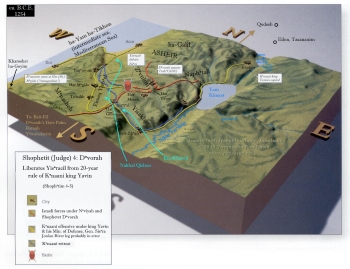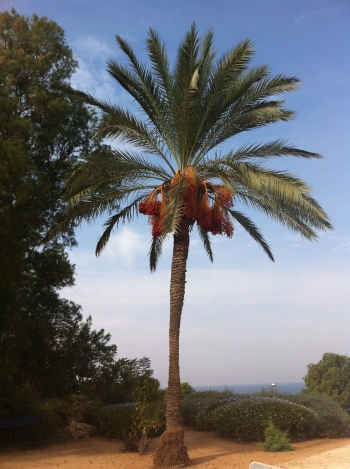
 |

 |
After the death of Sho•pheitꞋ #2 (Ei•hudꞋ Bën-Geir•âhꞋ![]() ), Bᵊn•eiꞋ-Yi•sᵊrâ•eilꞋ, yet again, strayed from Tōr•âhꞋ — constituting râ in the Eyes
), Bᵊn•eiꞋ-Yi•sᵊrâ•eilꞋ, yet again, strayed from Tōr•âhꞋ — constituting râ in the Eyes![]() of é‑‑ä.
of é‑‑ä.
As a result, é‑‑ä allowed Bᵊn•eiꞋ-Yi•sᵊrâ•eilꞋ to be subjugated by the military forces of the Kᵊna•an•iꞋ General SiꞋsᵊrâ,![]() Commander of the Southern Coastal Command Armored Corps (Chariots Division) for Yâ•vinꞋ, mëlꞋëkh Kᵊna•anꞋ, who reigned from his capital in Khâ•tzōrꞋ.
Commander of the Southern Coastal Command Armored Corps (Chariots Division) for Yâ•vinꞋ, mëlꞋëkh Kᵊna•anꞋ, who reigned from his capital in Khâ•tzōrꞋ.
 |
| úÌÉîÆø, |
Consequently Bᵊn•eiꞋ-Yi•sᵊrâ•eilꞋ cried-out to é‑‑ä via the court of Sho•phëtꞋët DᵊvōrꞋâh, a woman Nᵊvi•âhꞋ (wife of La•pid•ōtꞋ), who judged Bᵊn•eiꞋ-Yi•sᵊrâ•eilꞋ, holding court under "DᵊvōrꞋâh's Date-Palm Tree" (≈13 km/8 mi north of Yᵊru•shâ•laꞋyim).
So Bᵊn•eiꞋ-Yi•sᵊrâ•eilꞋ went to her there to adjudicate their legal disputes, complaining that they were harshly oppressed by the Kᵊna•an•iꞋ General SiꞋsᵊrâ, who commanded 900 iron![]() chariots operating out of his home town, 'Goy•imꞋ-Engraver City'),
chariots operating out of his home town, 'Goy•imꞋ-Engraver City'),![]() near the central coast.
near the central coast.
Hearing the overwhelming complaints against injustices at the hands of the Kᵊna•an•imꞋ, Sho•phëtꞋët DᵊvōrꞋâh summoned her own Defense Minister and Chief of Staff, Gen. Bâ•râqꞋ Bën-Av•i-NōꞋam, from QëdꞋësh of the Na•phᵊtalꞋi tribal region in the Gâ•lilꞋ.
 350x263.jpg) |
When Gen. Bâ•râqꞋ appeared before her bench, Sho•phëtꞋët DᵊvōrꞋâh chastised him. "Did you not get my order from this court informing you that é‑‑ä commands you? —
“Muster 10,000 soldiers from the tribes of Na•phᵊtalꞋi and Zᵊvul•unꞋ in the Gâ•lilꞋ and lead them down out of the hills south to the EiꞋmëq Yi•zᵊrᵊël plain around Har Tâ•vōrꞋ! Thereby, I will bait Yâ•vinꞋ's Minister of Defense, along with his armored corps and army, northward into a trap: when his chariots attempt to cross NaꞋkhal Qish•ōnꞋ to engage you, you will ambush
them while they trying to ferry their chariots across the naꞋkhal.”
But Gen. Bâ•râqꞋ had no faith that Sho•phëtꞋët DᵊvōrꞋâh's order was "the Lord's command". Rolling his eyes ![]() he replied, "If you really have faith that strategy is going to defeat Gen. SiꞋsᵊrâ's 900 chariots, then you come along with us and lay your life on the line too," he challenged. "Otherwise, no."
he replied, "If you really have faith that strategy is going to defeat Gen. SiꞋsᵊrâ's 900 chariots, then you come along with us and lay your life on the line too," he challenged. "Otherwise, no."
"Absolutely, I'll go with you!" she retorted. "Then your glory on this trip shall be zero because é‑‑ä shall deliver Gen. SiꞋsᵊrâ into the hand of a woman!"
So Sho•phëtꞋët DᵊvōrꞋâh got up and accompanied Gen. Bâ•râqꞋ north to his HQ at QëdꞋësh, where he mustered a 10,000 man force of the tribes of Zᵊvul•unꞋ and Na•phᵊtalꞋi. And Sho•phëtꞋët DᵊvōrꞋâh went up with him.

Optional parental preparation:
What are the "Eyes of é‑‑ä"? What is the origin of that phrase? (Ans: WadꞋjet, the Eye of HōrꞋus). ![]()
This documentation of the existence of a fleet of 900, operational, áÌÇøÀæÆì chariots at this time (c BCE 1348, currently assigned by archeologists & historians to the Levant-Late/Syrian-Middle Bronze Age) implies that the Iron Age in the Levant occurred at least 1½ centuries earlier than currently assigned. ![]()
Many researchers ignore the specification, in v.6, that this was QëdꞋësh of the Na•phᵊtalꞋi tribal region in the Gâ•lilꞋ, not in the coastal lowlands to the south. Archeologists locate this QëdꞋësh north of Khâ•tzōrꞋ.![]()
The resulting map demonstrates that this was not the simplistic case of north v south, all of which, during that era, was riddled with conflict; not only between Egyptian overlords v Syrian or eastern overlords, but, also, infantry forces holding the high ground in the mountains v plains-anchored armored corps (chariot-centric forces limited to reasonably-level ground). This was a conflict between the 'Mountain Forces' of the Israeli Gâ•lilꞋ (Zᵊvul•unꞋ and Na•phᵊtalꞋi tribal lands) v the Kᵊna•an•imꞋ 'Lowlanders' of the coastal plain and the Jordan Rift.
To neutralize the threat from Gen. SiꞋsᵊrâ's 900 chariots, Sho•phëtꞋët DᵊvōrꞋâh likely timed her uprising in very early spring, when the naꞋkhal was most swollen and the threat of flooding after a big rain was greatest; then ambushing the Kᵊna•an•imꞋ chariots as the first contingent was finishing off-loading onto the near (north, Gâ•lilꞋ-side) bank. Gen. SiꞋsᵊrâ was then committed to the crossing. He could not abandon his first wave of armored corps chariots. ![]()
How is plowing like engraving?
Questions you might anticipate that your child might raise and be prepared to discuss:
What does the verb & noun, "stray," mean? (What is a verb? Noun?)
What does "constitute" mean?
What does "subjugate" mean?
What is an "Armored Corps"?
What is a "capital"?
What does it mean to be "oppressed"?
What does "chastise" mean?
What is the "bench" in a court?
What does "muster" (troops) mean?
What is a "tribe"?
What's the difference between a naꞋkhal and other kinds of rivers, streams or brooks?
What does it mean to "ferry" something across water?
What was an English "lord" when the KJ/V was created?
What does it mean to "roll one's eyes"?
What is "glory"?
What is "zero"?
What is "HQ"? (headquarters)
![]()
 |
 |